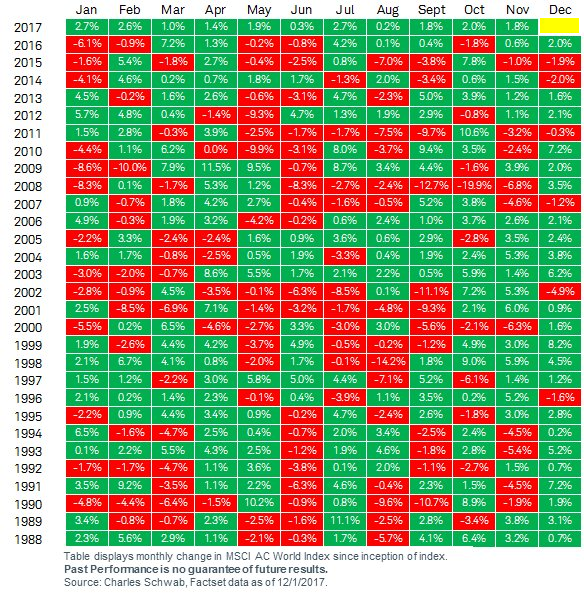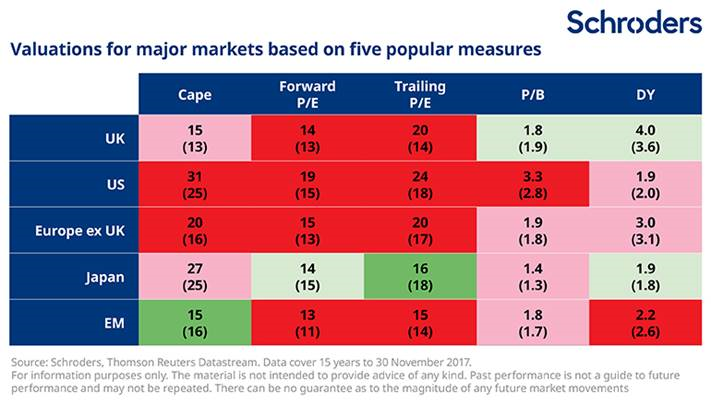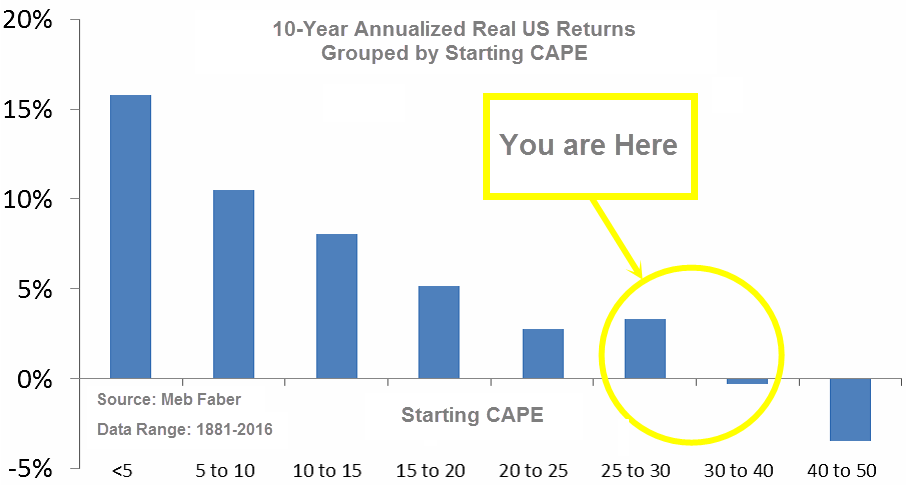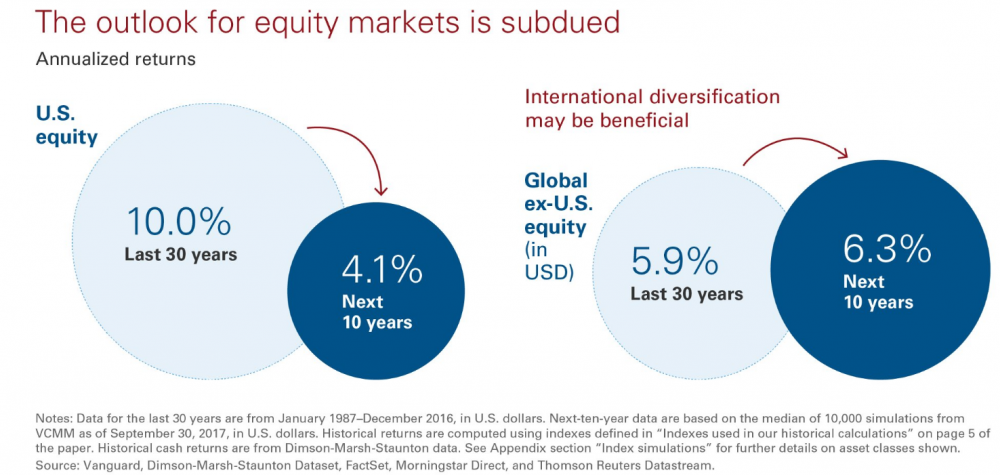
In a year of uncertainty that included a recalcitrant North Korea, Britain’s continued exit from the European Union, multiple terrorist attacks, and global populist uprisings, to say 2017 was a turbulent year is a bit of an understatement—except, that is, in stock markets.
World stocks, as measured by the MSCI All-Country World Index rose every month in 2017 (up approximately 1.45% in December). In fact, they haven’t had a negative return since October of 2016.

Major indexes in the U.S. hit a number of record highs, and there was not a single down month the entire year for the S&P 500 Total Return Index. The gains, however, have caused equity valuations to be stretched by almost all traditional metrics. By most measures, the US equity market is at its most overbought level in over 20 years. Duncan Lamont, head of research and analytics at Schroders Investment Management, writes that there is still some value in the market, “but it is hard work finding it.” In the following chart from Schroders, Dividend Yield is the only metric where the S&P 500 might be attractively valued compared to its 15-year average value (shown in parentheses). However, the reading of most concern is the CAPE, or cyclically-adjusted price-to-earnings multiple. The CAPE compares the S&P to its average, annual inflation-adjusted earnings over the previous 10 years. The current CAPE reading of 31 is above the 15-year average of 25, and nearly twice the long-term average of 16.8 that goes back to 1881. The only other times it has been above 30 were in 1929, before the Great Depression, and from 1997-2002, at the apex of the dot.com bubble. Some analysts say “It’s different this time”, citing rising profits from the new tax laws and differing accounting standards now vs then. Nonetheless, whenever one hears “It’s different this time” usually turns out to be a good time to look around the room for a door marked “Exit”! In this chart, Cape = CAPE, P/E = price to earnings, P/B = price to book value, DY = dividend yield and EM = Emerging Markets.

10 year annualized returns for the S&P 500, based on starting CAPE:

Lastly, Vanguard's 10 year forward return projections for both US and International equities:

A globally diversified portfolio of asset classes and strategies is a concept we believe to be both timeless and universal, but perhaps never more than today to still give investors a realistic chance to meet their long term required rate of return.
Jesse Blom is a licensed investment advisor and Vice President of Lorintine Capital, LP . He provides investment advice to clients all over the United States and around the world. Jesse has been in financial services since 2008 and is a CERTIFIED FINANCIAL PLANNER™ . Working with a CFP® professional represents the highest standard of financial planning advice. Jesse has a Bachelor of Science in Finance from Oral Roberts University. Jesse is managing the LC Diversified portfolio and forum, the LC Diversified Fund, as well as contributes to the Steady Condors newsletter.
What Is SteadyOptions?
Full Trading Plan
Complete Portfolio Approach
Diversified Options Strategies
Exclusive Community Forum
Steady And Consistent Gains
High Quality Education
Risk Management, Portfolio Size
Performance based on real fills
Non-directional Options Strategies
10-15 trade Ideas Per Month
Targets 5-7% Monthly Net Return
Recent Articles
Articles
Pricing Models and Volatility Problems
Most traders are aware of the volatility-related problem with the best-known option pricing model, Black-Scholes. The assumption under this model is that volatility remains constant over the entire remaining life of the option.
By Michael C. Thomsett, August 16

- Added byMichael C. Thomsett
- August 16
Option Arbitrage Risks
Options traders dealing in arbitrage might not appreciate the forms of risk they face. The typical arbitrage position is found in synthetic long or short stock. In these positions, the combined options act exactly like the underlying. This creates the arbitrage.
By Michael C. Thomsett, August 7

- Added byMichael C. Thomsett
- August 7
Why Haven't You Started Investing Yet?
You are probably aware that investment opportunities are great for building wealth. Whether you opt for stocks and shares, precious metals, forex trading, or something else besides, you could afford yourself financial freedom. But if you haven't dipped your toes into the world of investing yet, we have to ask ourselves why.
By Kim, August 7

- Added byKim
- August 7
Historical Drawdowns for Global Equity Portfolios
Globally diversified equity portfolios typically hold thousands of stocks across dozens of countries. This degree of diversification minimizes the risk of a single company, country, or sector. Because of this diversification, investors should be cautious about confusing temporary declines with permanent loss of capital like with single stocks.
By Jesse, August 6

- Added byJesse
- August 6
Types of Volatility
Are most options traders aware of five different types of volatility? Probably not. Most only deal with two types, historical and implied. All five types (historical, implied, future, forecast and seasonal), deserve some explanation and study.
By Michael C. Thomsett, August 1

- Added byMichael C. Thomsett
- August 1
The Performance Gap Between Large Growth and Small Value Stocks
Academic research suggests there are differences in expected returns among stocks over the long-term. Small companies with low fundamental valuations (Small Cap Value) have higher expected returns than big companies with high valuations (Large Cap Growth).
By Jesse, July 21

- Added byJesse
- July 21
How New Traders Can Use Trade Psychology To Succeed
People have been trying to figure out just what makes humans tick for hundreds of years. In some respects, we’ve come a long way, in others, we’ve barely scratched the surface. Like it or not, many industries take advantage of this knowledge to influence our behaviour and buying patterns.

- Added byKim
- July 21
A Reliable Reversal Signal
Options traders struggle constantly with the quest for reliable
By Michael C. Thomsett, July 20

- Added byMichael C. Thomsett
- July 20
Premium at Risk
Should options traders consider “premium at risk” when entering strategies? Most traders focus on calculated maximum profit or loss and breakeven price levels. But inefficiencies in option behavior, especially when close to expiration, make these basic calculations limited in value, and at times misleading.
By Michael C. Thomsett, July 13

- Added byMichael C. Thomsett
- July 13
Diversified Leveraged Anchor Performance
In our continued efforts to improve the Anchor strategy, in April of this year we began tracking a Diversified Leveraged Anchor strategy, under the theory that, over time, a diversified portfolio performs better than an undiversified portfolio in numerous metrics. Not only does overall performance tend to increase, but volatility and drawdowns tend to decrease: